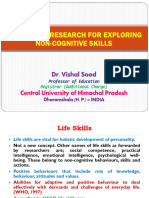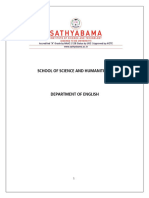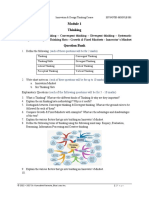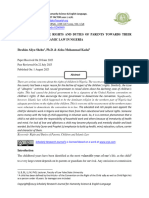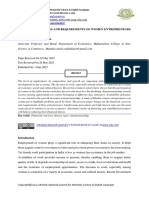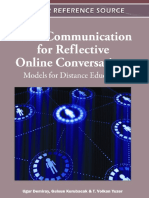Life Skill Education: Stastus, Practice and Policy in India
Life Skill Education: Stastus, Practice and Policy in India
Uploaded by
Anonymous CwJeBCAXpCopyright:
Available Formats
Life Skill Education: Stastus, Practice and Policy in India
Life Skill Education: Stastus, Practice and Policy in India
Uploaded by
Anonymous CwJeBCAXpOriginal Title
Copyright
Available Formats
Share this document
Did you find this document useful?
Is this content inappropriate?
Copyright:
Available Formats
Life Skill Education: Stastus, Practice and Policy in India
Life Skill Education: Stastus, Practice and Policy in India
Uploaded by
Anonymous CwJeBCAXpCopyright:
Available Formats
Scholarly Research Journal for Humanity Science & English Language ,
Online ISSN 2348-3083, SJ IMPACT FACTOR 2016 = 4.44, www.srjis.com
UGC Approved Sr. No.48612, OCT- NOV 2017, VOL- 4/24
https://doi.org/10.21922/srjhsel.v4i24.10401
LIFE SKILL EDUCATION: STASTUS, PRACTICE AND POLICY IN INDIA
Geeta Shinde, Ph. D.
Assistant Professor, Department of Education & Extension, Savitribai Phule Pune
University, Pune
Now a day’s parents, teachers, students, institutes, policy makers, and politicians also talking about
life skills. They consider that “We should not give the only a text book knowledge to our child, we
should provide them all skills which required for excellent life .If you want to say say I am human or
we are social animals then you must acquire the skills which defined by the WHO.These are known as
communication,critical thinking, creativity, self-awareness, decision making, problem
solving,empathy, interpersonal relationship ,these all require for coping with stress and coping with
emotions.This paper is focus based on literature reviews,how this skills are nurtured not only our
education system overall human life. Along with trying to focus life skill policy and practices.
Keywords: life skills, education, UNICEF, WHO, Policy
Scholarly Research Journal's is licensed Based on a work at www.srjis.com
Introduction:
Skills and knowledge are the driving force of economic growth and social development for
any developed or developing countries. India currently focusingseveral shortagesof well
trained, well skilled workers.It is estimated that only 2.3% of the workplace in India,has
undergone formal skill training as compared to 68%in Germany,52% in USA and 80% in
Japan and 96% in South Korea.Large section ofthe educated workforce have few or no job
skills making them largely unemployable. ThereforeIndia must focus on scaling up skill
training efforts to meet the demands of employers and increase economic growth.India is one
of the youngest nation in world more than 54% population below 25 years and 62% of are
working groups ,this is the great strength of India .India therefore has focusing on NMSD.in
which will provide the overall institutional frameworks to rapidly implement and scale up
skill development efforts across India.
Defining life skills:
Before talking something about life skill, let’s try to understand what is the skills? Skills
mean ability to do taking great mastery, expertise or we can say skill mean professionalism
and talent.Skill is a type of work or activity which required special training and knowledge.
Copyright © 2017, Scholarly Research Journal for Interdisciplinary Studies
Dr. Geeta Shinde
(Pg. 6581-6587) 6582
Than what is the life skill? according the literature review life skill means problem solving
behavior used appropriately and responsibility in the management of personal affairs.They
are the set of human skills acquired via teaching or direct experience that are the used to
handle problems and questions commonly encountered in daily life. Most important 10 life
skills defined and listed by UNICEF.This skills basically based on Psychological and
interpersonal skills. Life skill education is very important and integral part in education
system, but it should not restarted only with value education, through a value education or
handicraft and project means not a life skill it’s beyond that. Indian education system has not
yet awakened to the necessity of life skill training prgramme in schools. WHO developed the
training modules on life skill with this it required the strong networking of good
educationalist, great psychologists, mental health professionals and pure policy makers for
effective implementation of life skill in schools, society and overall the world.
Shifting life skill concept from “Survival and Income generation skills-live hood skill” to
“every individuals capacity to fully function and participate in daily life-Part of life”
UNICEF standards for Life skill education:
UNICEF designed quality standards for life skill education in five steps.
Standard 1 Life skill education need based (child centric)
Outcome
Standard 2 Life skill education is result based
Assessment
Standard 3 Life skill learning is knowledge, attitude and skill based
Activities
Standard 4 Teachers are trained on method and psychological support
Teaching based
Standard5 Life skill education is provided in protective and enabling
Learningenvironment environment with access to community service.
Ref. Carneiro, Crawford &Goodman(2007) the impact of early cognitive and non cognitive
skills on later outcomes.
Effective life skill approaches driven by many aspects.it is classified in four important
aspects.
Programme content: Developingrelevantinformation ,attitudes, skills and reinforcement.
Teacher Training: building teachers belief and potential of life skills education and their
capacity to impart such skills.
Copyright © 2017, Scholarly Research Journal for Interdisciplinary Studies
Dr. Geeta Shinde
(Pg. 6581-6587) 6583
Commitment: Advocating for the integration of life skill education delivery, allowing us to
analyze the status of life skill education policy and practices in India.
Categorizing life skill:Life skill encompass a wide ranging and often unstructured set of
skills and attitudes that is different to rightly define that some time it’s called non cognitive
and non academic skills ,but we know every skills need for best academic achievement.Same
it’s known as 21st century skills, soft skills ,social and emotional learning skills
Following table showing how the life skills have been defined and categorized in different
contexts.
World Health Collaborative for Character 21st Century Hilton
Organization academic, social Lab skills Pellegrino
(WHO) & emotional Framework
learning(CASEL)
Decision Self Awareness- Curiosity Learning Cognitive
making Accurately Skills- Competencies-
assessing one’s Critical Cognitive
feeling Thinking Process
Creative Knowledge
thinking Creativity
collaborating Innovations
Communicating
Self Gratitude Literacy Intrapersonal
Problem Management- Skills- Competencies-
Solving Regulating one’s Information Work Ethic
emotions to Media Positive Self
handle stress, Technology evolution
impulses. Intellectual
Openness
Creative Relationship Enthusiasm
Thinking skills-
Maintain healthy
and rewarding
Relationships Life Skills- Interpersonal
Flexibility Competencies-
Critical Responsible Optimism Initiative Teamwork
Thinking Decision Productivity Collaboration
Communication Making- Social Leadership Leadership
Making & Intelligence
Interpersonal respecting own& Self control
skill others decision
Self Awareness Grits
Empathy
Coping with
Stress
Coping with - - - -
Emotions
Copyright © 2017, Scholarly Research Journal for Interdisciplinary Studies
Dr. Geeta Shinde
(Pg. 6581-6587) 6584
Ref. Carneiro, Crawford &Goodman(2007) the impact of early cognitive and non cognitive
skills on later outcomes.
Current Status of Life Skill Education:
Central Board of Secondary Education (CBSE) in 2003, Introduce life skill education
as an integral part of the curriculum through continuous and comprehensive Education
(CBSE) for class six to ten. Sarvashikshaabiyan (SSA) also has under its agenda, life skills
training for give in on upper classes.
Why Learning Life Skills?
1) Learning to know: Developing Reasoning
It relates to Cognitive life skills such as a critical thinking, problem solving and
dicssion making skill. It thus refers to both the acquisition of knowledge as well as
the use of knowledge
2) Learning to be :Enhancing Agency It relates to sell management life skills related to
self awareness sell esteem &self-confidence and coping skills
3) Learning to live together: Building Potential through Social Capital. It relates to
communication skills, negotiation skills, refusal skill, Assertiveness skills,
Interpersonal skills, co-operation skills & empathy skills.
4) Learning to Do : Functioning and capabilities
It refers to central human, functional capabilities of life, health, integrity and control
over one’s environment.
Challenges in Integrating Life Skills:
1) Definition and understanding of life skill. As per describe in above WHO, UNICFF,
CACEL and others explain in a broad and multidimensional concept sure about which life
skill suitable for which age group is required. which activities or programme might be
optimal.
2) Limited evidence in developing countries about life skillstext. If we see there is very less
evidence based on research and less documentation.
3) Prescriptive approachalways this correlate with value education. There is lack between aim
of life skill and actual school environment incontext of practical building targeted skills,
attitude and knowledge in new generation.
4) Teacher Mindset: Practice of traditional teaching & learning system is seems everywhere.
In the teaching of life skills is different task. Because teacher equipped in their own
Copyright © 2017, Scholarly Research Journal for Interdisciplinary Studies
Dr. Geeta Shinde
(Pg. 6581-6587) 6585
knowledge , attitude, and skills to teach . They need clear framework of life skills pedagogy,
which skills, which age, which methods and how should be taught.
5) Competing Prioritiesand policy Support: UNICEF and WHO trying to inculcate all
these life skills among the students.life skill is a integral part of education butstill there is no
specific guideline for all. Which life skill for which age groups and which will be teach in
priority
6) Poor and uneven implementation in schools:
Lack of the proper guideline of plan ,procedure, training and implementation of life skill
education it it’s run in schools in different way and on different track
Track I (Carrier)Through Subject of Unit (Short Term Option)
Track II Separate Subject (Long term Option)
Track III Infusion or Integration (Not Recommended)
Priority Actions of Life Skills:
From Towards
Small scale National Coverage
Isolated education Programe Comprehensive (Fresh)
Single Carrier SubjectIntegration
(Focusing, Resources, Effective School Health Ref UNESCO, UNICEF, WLTO, World
Bank)
National Skill Development Mission 2015: (NSDM)
This mission was approved by union cabinet on 1/7/2015 and officially launch by the
hon’ble Prime Minister Narendra Mode on 15/7/2017 on the occasion of world Youth skill
day. This mission to focused on “Skilled India” this not only controlled and coordinate skill
efforts but also expedite decision making across sectors to achieve skilling at each skill
development and entrepreneurship this mission directly linked with three institutes.
1) National skill development Agency (NSDA)
2) National Skill development Corporation (NSDC)
3) Directorate General & Training (DGT)
Objectives of NSDM
1) Institutional Training
2) Infrastructure
3) Convergence
Copyright © 2017, Scholarly Research Journal for Interdisciplinary Studies
Dr. Geeta Shinde
(Pg. 6581-6587) 6586
5) Overseas employment
6) Sustainablelive hood
7) leveraging public infrastructure
National Skill Development Initiative in India 2009(NSDII)
1) Scale of Ambition :In 2009 the capacity of skill development arounel 3.1 million
person the 5th plan envisions at 15 million and India target 500 million skill workers
by 2022.
2) High Inclusivity :VNSDII be live that this mission support inclusivity inrespective of
male, female, urban, rural…
3) Demand based system planning :Develop the ebanging demands of employment &
technologies.
4) Choice, competition and accountability :This mission does not discriminate
between private or public delivery and places importance on outcomesy user choice
and competition among training providers and their accountability.
5) Policy Corrdination and coherence :This is support employment generation
economic growth and social development process. Economic, labor and social
policies and program development is the integral part of skill development policy.
Role & Responsibility of Employers/Institutes:
There are several role and responsibilities given by NSDII but I want to highlight only those
which are related to skill development.
1) Owning skill development activities.
2) Skill demand analysis and curriculum development
3) Supporting skill development of other
4) Investing in life skill development activities
Outcome of life Skill Development Policy:
1. Expansion of out reach using established as well as innovative approaches.
2. System to deliver, competencies in line with national & international recognized
standards
3. Focus on new emerging occupations
4. Life long learning
5. Equity consideration
6. Stress on research, planning monitoring
Copyright © 2017, Scholarly Research Journal for Interdisciplinary Studies
Dr. Geeta Shinde
(Pg. 6581-6587) 6587
7. Involvement in social partners
8. Promoting excellence
9. Use modern training technologies (web-e, distance learning)
Conclusion:
In every situation of life, we use some skills. Thinking out of the box can often find solution
to seeming difficult problem. According UNICEF it’s divided all skills in three areas
knowledge,attitude and skills. Education is very important butlive life better is more
important also. Education has to support for life skill education, training, functioning and
develop capabilities life skill education in our curriculum but still need more focus on it. Due
to globalization, moderation human life under the lot of stress. Many issues like alcoholism,
drugs, abuse, smoking, anti-social act, depression, competition, unemployment, mental
physical stress n number of problems surrounding us. Through the life skill education
everyone can able to coup with all this problems and they can make their life better.
Selected References:
Carneiro,Crawford and Goolman,(2007)The Impact Of early cognitive and non-cognitive skills on
later outcome
https://www.indiaeducationview.com
https://www.ijear.org
https://www.pursuit-of-happiness.org
https://en.wikipedia.org/wiki/Life_skills
https://www.skilldevelopment.gov.in
https://www.eric.ed.gov
https://www.centralsquarefoundation.org/wp-content/.../Life-Skills-Education-in-India
Copyright © 2017, Scholarly Research Journal for Interdisciplinary Studies
You might also like
- Programme Handbook PsychologyDocument19 pagesProgramme Handbook PsychologyEmilyNo ratings yet
- Life SkillsDocument25 pagesLife SkillsMaria JacqulinNo ratings yet
- Ubd Chapter 5 - Essential Questions 1Document5 pagesUbd Chapter 5 - Essential Questions 1api-651337707No ratings yet
- Integrating 21st Skills in TVET Institution in ASEANDocument23 pagesIntegrating 21st Skills in TVET Institution in ASEANFnu Paryono100% (2)
- Life Skill Education PDFDocument8 pagesLife Skill Education PDFChiranjibi Behera Chiru100% (7)
- Paul, Elder and Bartell - Critical ThinkingDocument196 pagesPaul, Elder and Bartell - Critical ThinkingJosé AntonioNo ratings yet
- Royce WR - Transversal CompetenciesDocument8 pagesRoyce WR - Transversal CompetenciesRoyce IbuanNo ratings yet
- VIDYA - Life Skills Program 2016Document5 pagesVIDYA - Life Skills Program 2016Swapnalee GuravNo ratings yet
- Vaed MidtermsDocument5 pagesVaed MidtermsNikolle GucelaNo ratings yet
- Life Skill EducationDocument53 pagesLife Skill Educationganesh sakkaraiNo ratings yet
- Vishal SoodDocument35 pagesVishal Soodganeshvaliachi94No ratings yet
- WBOLS Layout 15-10-08Document60 pagesWBOLS Layout 15-10-08Samudrala JayaPrakash NarayanaNo ratings yet
- Curri PPT Dec 2022Document13 pagesCurri PPT Dec 2022Jessa LuzanoNo ratings yet
- Life Skills With Emma Sue Prince PDFDocument50 pagesLife Skills With Emma Sue Prince PDFMuhammadBahaUdinNo ratings yet
- Introduction To Life Skills - Module 1Document40 pagesIntroduction To Life Skills - Module 1ashnaraghav5No ratings yet
- First Steps To Becoming A TrainerDocument49 pagesFirst Steps To Becoming A TrainerbusinessdatabasesNo ratings yet
- 8.human Res - IJHRMR - Building CareerDocument6 pages8.human Res - IJHRMR - Building CareerTJPRC PublicationsNo ratings yet
- Social AwarenessDocument15 pagesSocial AwarenessRavanNo ratings yet
- Emotional Intelligence in LeadershipDocument5 pagesEmotional Intelligence in LeadershipInternational Journal of Innovative Science and Research TechnologyNo ratings yet
- Presentation 6Document5 pagesPresentation 6Mehedi RomanNo ratings yet
- A Emotional Intelligence 119Document23 pagesA Emotional Intelligence 119ruby786No ratings yet
- Emotional Intelligence Presentation 2016 1Document21 pagesEmotional Intelligence Presentation 2016 1Swati ChamariaNo ratings yet
- Narrative ReportDocument3 pagesNarrative ReportHoney Joy JuanNo ratings yet
- The Life Skills HandbookDocument16 pagesThe Life Skills Handbookkasialways4u100% (1)
- SHS1307Document161 pagesSHS1307rddesigns85No ratings yet
- A Study On Life Skill of Senior SecondarDocument9 pagesA Study On Life Skill of Senior SecondarjustarunjiNo ratings yet
- EQ For Leadership EffectivenessDocument22 pagesEQ For Leadership EffectivenessM ManjunathNo ratings yet
- Introduction To Life SkillsDocument17 pagesIntroduction To Life SkillsesseytesterNo ratings yet
- Emotional Skills Assessment Full DescriptionDocument4 pagesEmotional Skills Assessment Full DescriptionAdriana CocianNo ratings yet
- Narrative ReportDocument4 pagesNarrative ReportHoney Joy JuanNo ratings yet
- Aemotional Intelligence 119Document23 pagesAemotional Intelligence 119api-19967160100% (1)
- Intro To HRD Week 5Document8 pagesIntro To HRD Week 5afdalizaNo ratings yet
- Aboriginal Games UnitDocument10 pagesAboriginal Games Unitapi-339208033No ratings yet
- Organizational Leadership & Individual Towards Creativity.: Topic 8Document39 pagesOrganizational Leadership & Individual Towards Creativity.: Topic 8Siti Aishah100% (1)
- Developing Emotional Intelligence 09 29 15HODocument32 pagesDeveloping Emotional Intelligence 09 29 15HOkeziaNo ratings yet
- BiZ3 Developing Enterprising Skills S-1Document7 pagesBiZ3 Developing Enterprising Skills S-1chloptigerNo ratings yet
- Annexure 3 - Personality Enhancement ProgramDocument11 pagesAnnexure 3 - Personality Enhancement Programashish mishraNo ratings yet
- Emotional Intelligence Workshop - Sheelagh McGroganDocument62 pagesEmotional Intelligence Workshop - Sheelagh McGroganRobertNo ratings yet
- Emotional IntelligenceDocument14 pagesEmotional IntelligenceoluwatimileyinjaNo ratings yet
- 733 3561 1 PB PDFDocument4 pages733 3561 1 PB PDFAmandeep KaurNo ratings yet
- Life SkillsDocument56 pagesLife SkillsNilesh PanditNo ratings yet
- SS-I Unit - 5 Study MaterialsDocument24 pagesSS-I Unit - 5 Study MaterialsSATC Media & CommunicationNo ratings yet
- ESCI - University EditionDocument24 pagesESCI - University EditionLeonidas ArchilaNo ratings yet
- IJREAMV07I0476011Document10 pagesIJREAMV07I0476011Jaffar SadiqNo ratings yet
- Best Team & Worst Team ExerciseDocument33 pagesBest Team & Worst Team ExerciseAyesha BanoNo ratings yet
- EQ Skills For Team Leaders and ManagersDocument51 pagesEQ Skills For Team Leaders and Managersbakhtawar100% (1)
- Presentasi LOB - Group II - CH 3 & 4Document47 pagesPresentasi LOB - Group II - CH 3 & 4Daniel AnthonyNo ratings yet
- Emotional Intelligence Improving Performance For Organizational BenefitsDocument30 pagesEmotional Intelligence Improving Performance For Organizational BenefitsAmna AnsariNo ratings yet
- Esci - University Edition 1Document24 pagesEsci - University Edition 1api-576341191No ratings yet
- DIASS Module 2 Unit 1-3Document36 pagesDIASS Module 2 Unit 1-3Marianne Sy-Quimsiam Ignacio100% (2)
- Life Skill Education and Adolescent LearDocument12 pagesLife Skill Education and Adolescent LearSOURABH ANANDNo ratings yet
- Emotional Intelligence at Workplace - A Conceptual StudyDocument4 pagesEmotional Intelligence at Workplace - A Conceptual StudyrakulNo ratings yet
- IowasSocial EmotionalLearningCompetenciesDocument76 pagesIowasSocial EmotionalLearningCompetenciesLiliana Sandu100% (1)
- Reviewer in Family and Consumer SkillsDocument15 pagesReviewer in Family and Consumer SkillsKevin Nichols Abacan100% (3)
- Life Skill SLM - 0Document105 pagesLife Skill SLM - 0AmaldevvsNo ratings yet
- 12 Psychology Notes VariationinpsychologicalattributesDocument1 page12 Psychology Notes Variationinpsychologicalattributes4tfhfbwcptNo ratings yet
- IDT UVCE Module 1 ThinkingDocument25 pagesIDT UVCE Module 1 ThinkingShamanth C KNo ratings yet
- Interpersonal EffectivenessDocument19 pagesInterpersonal EffectivenessGuyNo ratings yet
- Report - Emotional IntelligenceDocument36 pagesReport - Emotional IntelligenceSamarth JoshiNo ratings yet
- Report Emotional Intelligence Web PDFDocument36 pagesReport Emotional Intelligence Web PDFarun prakash.mNo ratings yet
- Emotional & Social IntelligenceDocument20 pagesEmotional & Social IntelligencescienceharikrishnaNo ratings yet
- Emotional Intelligence 101: Developing EQ for Success in Life and WorkFrom EverandEmotional Intelligence 101: Developing EQ for Success in Life and WorkNo ratings yet
- 1.prof. Ajay Kumar AttriDocument8 pages1.prof. Ajay Kumar AttriAnonymous CwJeBCAXpNo ratings yet
- 25.suresh ChenuDocument9 pages25.suresh ChenuAnonymous CwJeBCAXpNo ratings yet
- 29.yuvraj SutarDocument4 pages29.yuvraj SutarAnonymous CwJeBCAXpNo ratings yet
- 13.nasir RasheedDocument9 pages13.nasir RasheedAnonymous CwJeBCAXpNo ratings yet
- Homesh RaniDocument7 pagesHomesh RaniAnonymous CwJeBCAXpNo ratings yet
- Investigation of The Satus of The Social Development Programs Under Sansad Adarsh Gram Yojana in Rajgoli Village in Kolhapur DistrictDocument12 pagesInvestigation of The Satus of The Social Development Programs Under Sansad Adarsh Gram Yojana in Rajgoli Village in Kolhapur DistrictAnonymous CwJeBCAXpNo ratings yet
- An Analysis of The Rights and Duties of Parents Towards Their Children Under Islamic Law in NigeriaDocument29 pagesAn Analysis of The Rights and Duties of Parents Towards Their Children Under Islamic Law in NigeriaAnonymous CwJeBCAXpNo ratings yet
- 19.Dr Ibrahim Aliyu ShehuDocument29 pages19.Dr Ibrahim Aliyu ShehuAnonymous CwJeBCAXpNo ratings yet
- Customers' Consciousness About Financial Cyber Frauds in Electronic Banking: An Indian Perspective With Special Reference To Mumbai CityDocument13 pagesCustomers' Consciousness About Financial Cyber Frauds in Electronic Banking: An Indian Perspective With Special Reference To Mumbai CityAnonymous CwJeBCAXpNo ratings yet
- Critical Analysis of Depression Among Higher Education Students of KolkataDocument12 pagesCritical Analysis of Depression Among Higher Education Students of KolkataAnonymous CwJeBCAXpNo ratings yet
- 4.Dr Gagandeep KaurDocument13 pages4.Dr Gagandeep KaurAnonymous CwJeBCAXpNo ratings yet
- Exploitation of The Ones Who Have No OneDocument15 pagesExploitation of The Ones Who Have No OneAnonymous CwJeBCAXpNo ratings yet
- Sociological Gaze of Tare Zameen ParDocument4 pagesSociological Gaze of Tare Zameen ParAnonymous CwJeBCAXpNo ratings yet
- Technostress, Computer Self-Efficacy and Perceived Organizational Support Among Secondary School Teachers: Difference in Type of School, Gender and AgeDocument13 pagesTechnostress, Computer Self-Efficacy and Perceived Organizational Support Among Secondary School Teachers: Difference in Type of School, Gender and AgeAnonymous CwJeBCAXpNo ratings yet
- Financial Concerns and Requirements of Women EntrepreneursDocument10 pagesFinancial Concerns and Requirements of Women EntrepreneursAnonymous CwJeBCAXpNo ratings yet
- A Study of Awareness About Online Information Resources of Student TeachersDocument7 pagesA Study of Awareness About Online Information Resources of Student TeachersAnonymous CwJeBCAXpNo ratings yet
- A Study On Pre-Investment Due Diligence by Capital Market Investors of Mumbai Suburban AreaDocument11 pagesA Study On Pre-Investment Due Diligence by Capital Market Investors of Mumbai Suburban AreaAnonymous CwJeBCAXpNo ratings yet
- Effect of Life Skill Training On Mental Health Among B.ed. Interns in Relation To Their Impulsive BehaviourDocument9 pagesEffect of Life Skill Training On Mental Health Among B.ed. Interns in Relation To Their Impulsive BehaviourAnonymous CwJeBCAXpNo ratings yet
- Empowerment and Education of Tribal Women in IndiaDocument12 pagesEmpowerment and Education of Tribal Women in IndiaAnonymous CwJeBCAXpNo ratings yet
- Historical Development of Play Schools in IndiaDocument11 pagesHistorical Development of Play Schools in IndiaAnonymous CwJeBCAXpNo ratings yet
- Aggression Among Senior Secondary School Students in Relation To Their Residential BackgroundDocument8 pagesAggression Among Senior Secondary School Students in Relation To Their Residential BackgroundAnonymous CwJeBCAXpNo ratings yet
- Context of Eco-Psychological ImbalanceDocument8 pagesContext of Eco-Psychological ImbalanceAnonymous CwJeBCAXpNo ratings yet
- Nep 2020: Analysis On Use of Technology and Its Integration in EducationDocument6 pagesNep 2020: Analysis On Use of Technology and Its Integration in EducationAnonymous CwJeBCAXpNo ratings yet
- The Need of Remote Voting Machine in Indian Voting SystemDocument7 pagesThe Need of Remote Voting Machine in Indian Voting SystemAnonymous CwJeBCAXpNo ratings yet
- The Impact of Mindfulness Exercise To Change The Body and MindDocument8 pagesThe Impact of Mindfulness Exercise To Change The Body and MindAnonymous CwJeBCAXpNo ratings yet
- The Use of English Language During PandemicDocument7 pagesThe Use of English Language During PandemicAnonymous CwJeBCAXpNo ratings yet
- Women Empowerment and Religion's Role in Gender Relations in KargilDocument10 pagesWomen Empowerment and Religion's Role in Gender Relations in KargilAnonymous CwJeBCAXpNo ratings yet
- 30 Trishala BhaskarDocument7 pages30 Trishala BhaskarAnonymous CwJeBCAXpNo ratings yet
- 31 Dr. Suman Kumari, Prof. Sudarshana Rana & Ms. Anita VermaDocument9 pages31 Dr. Suman Kumari, Prof. Sudarshana Rana & Ms. Anita VermaAnonymous CwJeBCAXpNo ratings yet
- 29 Balwinder SinghDocument8 pages29 Balwinder SinghAnonymous CwJeBCAXpNo ratings yet
- Alternative Learning System PDFDocument89 pagesAlternative Learning System PDFKnestor Luigi D. AbagNo ratings yet
- A Level English Literature Coursework PlanDocument6 pagesA Level English Literature Coursework Planafazbjuwz100% (2)
- How To Write A Critical Essay ExampleDocument3 pagesHow To Write A Critical Essay Exampleb725c62j100% (2)
- Thesis About Behavior Problems of StudentsDocument8 pagesThesis About Behavior Problems of StudentsCustomPaperServicesSingapore100% (2)
- Social StudiesDocument3 pagesSocial StudiesReynaldo Cantores Seidel Jr.No ratings yet
- CMI 500 - 2010 - Chapter 00 - Syllabus For Creativity and Innovation MGMT - Batch ADocument11 pagesCMI 500 - 2010 - Chapter 00 - Syllabus For Creativity and Innovation MGMT - Batch Ashivaprasad_ramaraoNo ratings yet
- 05 Critical Reading As Looking For Ways of ThinkingDocument43 pages05 Critical Reading As Looking For Ways of ThinkingBryan Callano88% (8)
- Lesson 4Document15 pagesLesson 4Maden betoNo ratings yet
- Demiray U., Kurubacak G., Yuzer T.v.-meta-Communication For Reflective Online Conversations - ModelsDocument321 pagesDemiray U., Kurubacak G., Yuzer T.v.-meta-Communication For Reflective Online Conversations - ModelshorrityNo ratings yet
- Standard 1 CSTP: Engaging and Supporting All Students in LearningDocument43 pagesStandard 1 CSTP: Engaging and Supporting All Students in LearningAlexandra BarlowNo ratings yet
- Challenges To Digital Literacy Ed.Document2 pagesChallenges To Digital Literacy Ed.Ethel Grace Curib100% (1)
- Malcolm Xs Literacy Behind Bars Thesis StatementDocument7 pagesMalcolm Xs Literacy Behind Bars Thesis Statementamandacroweverett50% (2)
- Geography Syllabus 2017-18Document3 pagesGeography Syllabus 2017-18api-366152870No ratings yet
- How To Write Literature Review For ThesisDocument9 pagesHow To Write Literature Review For Thesiswfwpbjvff100% (2)
- Two Kinds Amy Tan ThesisDocument4 pagesTwo Kinds Amy Tan ThesisHelpWithWritingPapersPittsburgh100% (2)
- (Value Inquiry Book Series - Studies in Existentialism, 279) Tove Pettersen, Annlaug Bjà Rsnã S, Margaret A. Simons - Simone de Beauvoir - A Humanist Thinker-Brill - Rodopi (2015) PDFDocument230 pages(Value Inquiry Book Series - Studies in Existentialism, 279) Tove Pettersen, Annlaug Bjà Rsnã S, Margaret A. Simons - Simone de Beauvoir - A Humanist Thinker-Brill - Rodopi (2015) PDFamnezioNo ratings yet
- Assessment Brief NX9523 2021Document12 pagesAssessment Brief NX9523 2021anniepangcqNo ratings yet
- Dissertation VoltaireDocument6 pagesDissertation VoltaireBestPaperWritingServiceCanada100% (1)
- Session 9 - Aligning Teaching Strategies With MELCS To Develop 21st Century Skills - Manuel L. Limjoco (Batch 2)Document38 pagesSession 9 - Aligning Teaching Strategies With MELCS To Develop 21st Century Skills - Manuel L. Limjoco (Batch 2)Maryjane Bailo LamelaNo ratings yet
- LDRS 500 D Syllabus SP 2024Document6 pagesLDRS 500 D Syllabus SP 2024Bhavini MataiNo ratings yet
- Teachers' Perception On Integrating Historical Vignettes in Teaching Science ConceptsDocument6 pagesTeachers' Perception On Integrating Historical Vignettes in Teaching Science ConceptsInternational Journal of Innovative Science and Research TechnologyNo ratings yet
- Handbook For Science TeachersDocument194 pagesHandbook For Science TeachersRay KinNo ratings yet
- New Module-Rhythmic-ActivitiesDocument112 pagesNew Module-Rhythmic-Activitiesromy imperialNo ratings yet
- Eap - Module 4.1Document4 pagesEap - Module 4.1Michael Angelo GodinezNo ratings yet
- College of Industrial Technology: Cagayan State UniversityDocument12 pagesCollege of Industrial Technology: Cagayan State UniversityWina FillomenaNo ratings yet
- Activity Participation and Older AdultsDocument8 pagesActivity Participation and Older AdultsIconMaicoNo ratings yet
- Lab MANUAL-advanced Reading and Writing-NwDocument41 pagesLab MANUAL-advanced Reading and Writing-Nwdurga67% (3)










